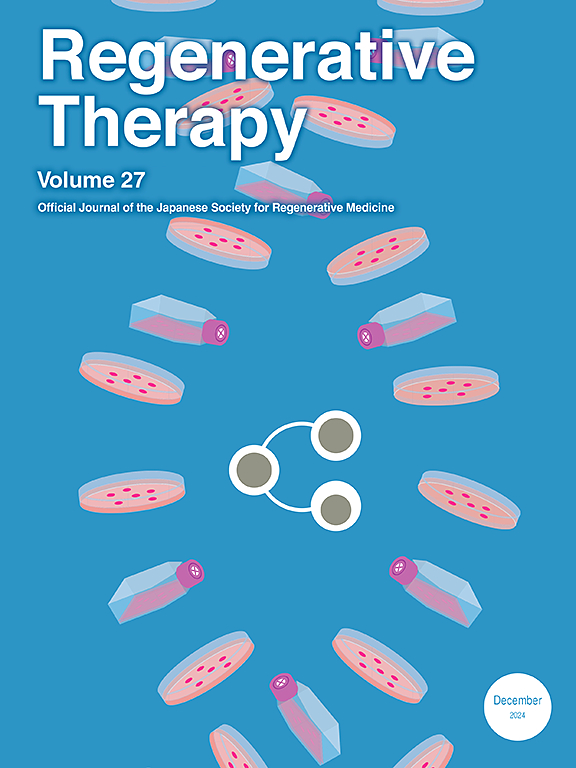Modified bFGF targeting connective tissue growth factor in the injured microenvironment improved cardiac repair after chronic myocardial ischemia
IF 3.4
3区 环境科学与生态学
Q3 CELL & TISSUE ENGINEERING
引用次数: 0
Abstract
Myocardial infarction (MI) was a cardiovascular emergency that led to heart failure, arrhythmia, and sudden death. Basic fibroblast growth factor (bFGF) was revealed to promote angiogenesis and protect cardiomyocytes against ischemic injury. But conventional delivery of bFGF in an uncontrolled manner was inefficient and diffusive, limiting its application in MI therapy. Currently, stimuli-responsive drug delivery is emphasized in tissue regeneration. The present study constructed a CFBP-bFGF recombinant protein, which could specifically target upregulated connective tissue growth factor (CTGF) and release bFGF in ischemic myocardium. In a rat model with MI, intravenous administration of CFBP-bFGF significantly accumulated in ischemic myocardium by targeting with CTGF. The responsive release of CFBP-bFGF effectively enhanced blood vessel regeneration, decreased cardiomyocyte apoptosis, and improved cardiac function recovery. In addition, the molecular mechanism was further explored by RNA sequencing and transcriptome analysis. Besides activating the pathways and genes related to angiogenesis and cardiac protection, CFBP-bFGF also decreased the expression of fibrosis-related pathways and genes, such as TGF-β. These results demonstrated that the CTGF-responsive CFBP-bFGF was effective for targeting release that promoted the functional recovery of MI.
损伤微环境中靶向结缔组织生长因子修饰的bFGF可改善慢性心肌缺血后的心脏修复
心肌梗死(MI)是一种心血管急症,可导致心力衰竭、心律失常和猝死。碱性成纤维细胞生长因子(bFGF)具有促进血管生成和保护心肌细胞免受缺血性损伤的作用。但传统的不受控制的bFGF递送效率低且弥漫性强,限制了其在心肌梗死治疗中的应用。目前,刺激反应性药物递送在组织再生中受到重视。本研究构建了CFBP-bFGF重组蛋白,该蛋白能够特异性靶向上调的结缔组织生长因子(CTGF),在缺血心肌中释放bFGF。在心肌梗死大鼠模型中,静脉给药CFBP-bFGF可通过CTGF靶向作用在缺血心肌中显著积累。CFBP-bFGF的响应性释放可有效促进血管再生,减少心肌细胞凋亡,促进心功能恢复。此外,通过RNA测序和转录组分析进一步探索其分子机制。除了激活血管生成和心脏保护相关的通路和基因外,CFBP-bFGF还降低了纤维化相关通路和基因的表达,如TGF-β。这些结果表明,ctgf响应的CFBP-bFGF能够有效地靶向释放,促进心肌梗死的功能恢复。
本文章由计算机程序翻译,如有差异,请以英文原文为准。
求助全文
约1分钟内获得全文
求助全文
来源期刊

Regenerative Therapy
Engineering-Biomedical Engineering
CiteScore
6.00
自引率
2.30%
发文量
106
审稿时长
49 days
期刊介绍:
Regenerative Therapy is the official peer-reviewed online journal of the Japanese Society for Regenerative Medicine.
Regenerative Therapy is a multidisciplinary journal that publishes original articles and reviews of basic research, clinical translation, industrial development, and regulatory issues focusing on stem cell biology, tissue engineering, and regenerative medicine.
文献相关原料
公司名称
产品信息
索莱宝
3-(4,5)-dimethylthiahiazo(-z-y1)-3,5-di-phenytetrazoliumromide (MTT)
索莱宝
DMSO
 求助内容:
求助内容: 应助结果提醒方式:
应助结果提醒方式:


